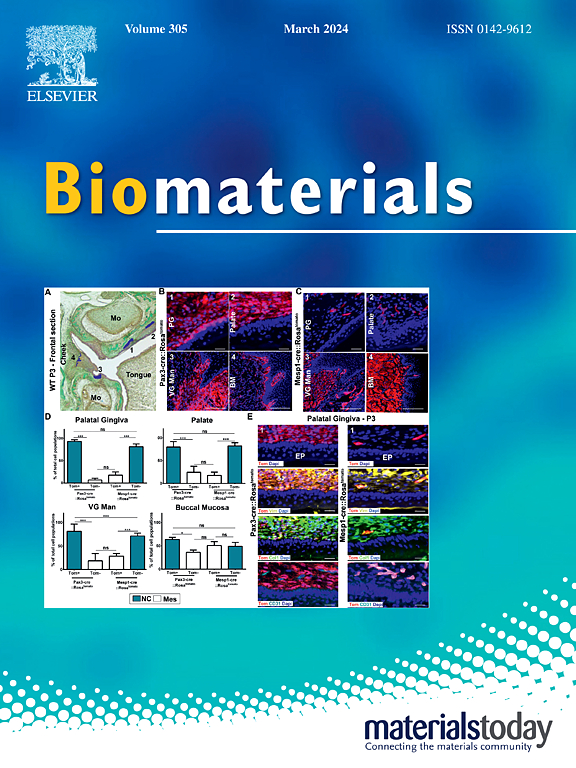具有胆固醇消耗能力的碳点修饰的可生物降解中空二氧化锰用于级联扩增超声免疫治疗
IF 12.8
1区 医学
Q1 ENGINEERING, BIOMEDICAL
引用次数: 0
摘要
为了有效地激活适应性免疫反应,促进树突状细胞(dc)的成熟并随后启动细胞毒性T淋巴细胞是至关重要的。然而,免疫抑制肿瘤微环境(TME)被认为会阻碍DC成熟,导致免疫治疗的有效性显著降低。在这项工作中,我们首次将ros触发的免疫原性细胞死亡(ICD)、胆固醇消耗和STING激活结合起来,实现了抗肿瘤免疫反应的级联扩增。以zr基金属有机骨架(MOF)为模板,合成了空心MnO2 (H-MnO2)。然后将具有胆固醇消耗能力的碳点(CDs)沉积在H-MnO2上形成异质结。CD@H -MnO2不仅由于异质结的构建提高了超声作用下ROS的生成能力,而且还表现出gsh响应降解特性,能够在肿瘤中靶向释放CDs和Mn离子。CD@H - mno2触发的抗肿瘤免疫反应级联扩增被阐明如下:(1)异质结的构建、GSH的消耗和缺氧的缓解共同增加了ROS的产量,可以显著诱导强大的ICD效应。(2)释放的Mn离子通过激活cGAS-STING通路刺激DC成熟。(3) CDs可通过消耗胆固醇实现对T细胞毒性的直接增强。已观察到显著的抗肿瘤作用,以消除原发肿瘤和阻止远处肿瘤的生长。这项研究提出了一种新的方法,将ros触发的ICD、胆固醇消耗和STING激活合并到一个纳米材料中,以产生持久而强大的免疫反应。本文章由计算机程序翻译,如有差异,请以英文原文为准。
Biodegradable hollow MnO2 decorated by carbon dots with cholesterol depletion capability for cascaded amplification of sono-immunotherapy
For the effective activation of the adaptive immune response, it is crucial to promote the maturation of dendritic cells (DCs) and subsequently initiate cytotoxic T lymphocytes. Nevertheless, the immunosuppressive tumor microenvironments (TME) are believed to hinder DC maturation, leading to a significant decrease in the effectiveness of immunotherapy. In this work, we present the first instance of combining ROS-triggered immunogenic cell death (ICD), cholesterol depletion, and STING activation to achieve the cascade amplification of antitumor immune response. The Zr-based metal-organic frameworks (MOF) is utilized as the template for the synthesis of hollow MnO2 (H–MnO2). Carbon dots (CDs) with cholesterol depletion capability are then deposited on H–MnO2 to form heterojunctions. CD@H–MnO2 not only has improved ROS generation ability under ultrasound due to heterojunction construction, but also shows GSH-responsive degradation properties, enabling the targeted release of CDs and Mn ions in tumors. CD@H–MnO2-triggered cascade amplification of antitumor immune response is elucidated as follows: (1) Heterojunction construction, GSH depletion, and relief of hypoxia co-augmented ROS yield could significantly induce a robust ICD effect. (2) The released Mn ions stimulate DC maturation by activating the cGAS-STING pathway. (3) Direct enhancement of T cell toxicity can be realized by CDs through depleting cholesterol. Notable antitumor effects have been observed to eliminate primary tumors and stop the growth of distant tumors. This study presents a novel method to merge ROS-triggered ICD, cholesterol depletion, and STING activation into one nanomaterial to produce long-lasting and powerful immune responses.
求助全文
通过发布文献求助,成功后即可免费获取论文全文。
去求助
来源期刊

Biomaterials
工程技术-材料科学:生物材料
CiteScore
26.00
自引率
2.90%
发文量
565
审稿时长
46 days
期刊介绍:
Biomaterials is an international journal covering the science and clinical application of biomaterials. A biomaterial is now defined as a substance that has been engineered to take a form which, alone or as part of a complex system, is used to direct, by control of interactions with components of living systems, the course of any therapeutic or diagnostic procedure. It is the aim of the journal to provide a peer-reviewed forum for the publication of original papers and authoritative review and opinion papers dealing with the most important issues facing the use of biomaterials in clinical practice. The scope of the journal covers the wide range of physical, biological and chemical sciences that underpin the design of biomaterials and the clinical disciplines in which they are used. These sciences include polymer synthesis and characterization, drug and gene vector design, the biology of the host response, immunology and toxicology and self assembly at the nanoscale. Clinical applications include the therapies of medical technology and regenerative medicine in all clinical disciplines, and diagnostic systems that reply on innovative contrast and sensing agents. The journal is relevant to areas such as cancer diagnosis and therapy, implantable devices, drug delivery systems, gene vectors, bionanotechnology and tissue engineering.
 求助内容:
求助内容: 应助结果提醒方式:
应助结果提醒方式:


